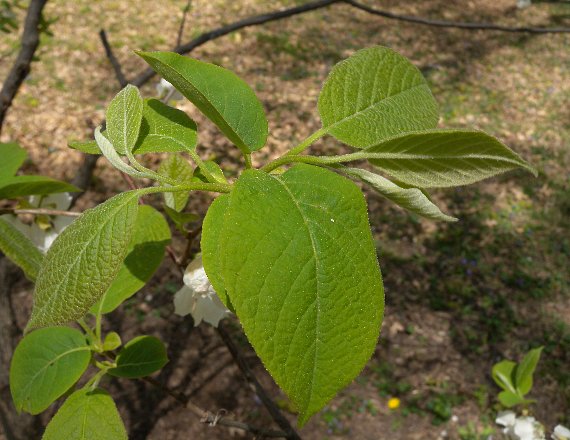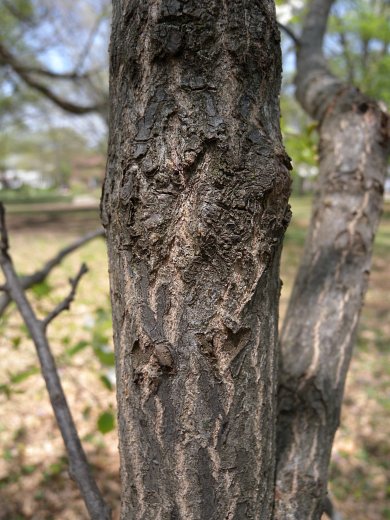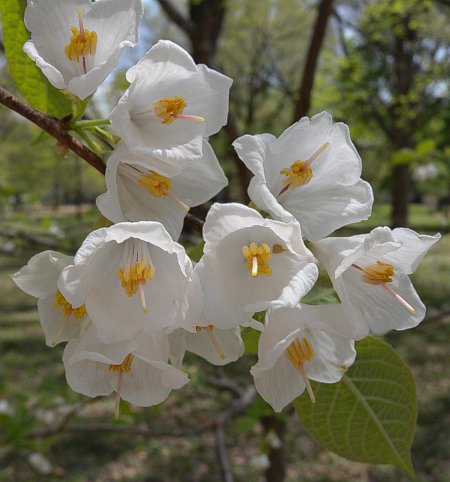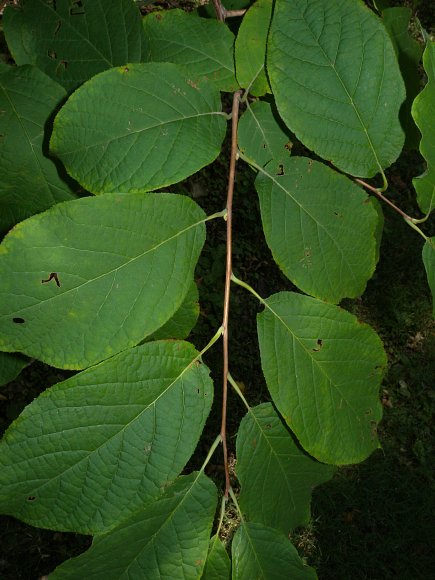
The slender petioles are ¼–¾" long and light green; they are pubescent while young, becoming glabrous (or nearly so) with age. Hanging clusters of 2-5 flowers occur along twigs of the preceding year. These flowers are ¾–1" long and a little less across, while their slender pedicels are ½–¾" long. Each flower consists of a white corolla that is bell-shaped (campanulate) and 4-lobed, a very short calyx with 4 widely spaced teeth, 8 or 16 stamens with white filaments and yellow anthers, and a pistil with a single exserted style. The lobes of the corolla are short, rounded, somewhat irregular, and often slightly recurved along their margins. The calyx is less than ¼" long, light green, obconic in shape, and short-pubescent. The pedicels of the flowers are light green and pubescent. The blooming period occurs from mid- to late spring for about 2 weeks while the vernal leaves are developing. The flowers bloom at about the same time, presenting a showy display. Afterwards, the flowers are replaced by fruits that become 1-2" long at maturity. These fruits are broadly ellipsoid, strongly 4-winged, and glabrous; they have slender beaks from the persistent styles.

Immature fruits during the summer are light green, while mature fruits during the autumn are brown; they persist on the shrub or tree during the winter after the deciduous leaves are gone. Inside each fruit, there is a single stone about ½–1" long. While each stone can contain up to 4 seeds, it usually has a single seed up to 8 mm. (1/3") long. The root system can send up new shoots if the trunk of this woody plant is damaged or cut. The leaves become greenish yellow, yellow, or yellowish brown during the autumn.
Cultivation: The preference is partial sun to medium shade, moist to mesic conditions, and loamy soil. This woody plant can bloom when it is only a few years old and 3-5' high. Its life expectancy is up to 100 years. Winter hardiness extends to Zone 5. Carolina Silverbell should be planted in locations that are protected from high winds as its wood is relatively weak and soft.

Range & Habitat: Native populations of Carolina Silverbell occur only at the southern tip of Illinois, where it is rare and state-listed as 'endangered' (see Distribution Map). This woody plant occurs primarily in SE United States, especially in the southern Appalachian mountains. Because it is sometimes cultivated as an ornamental shrub or tree, there exists the possibility of non-native populations occurring elsewhere in the state from escaped plants. In Illinois, Carolina Silverbell occurs in wooded ravines, along wooded slopes, and along wooded stream banks in high quality natural areas. These wooded areas are dominated by various deciduous canopy trees.

Faunal Associations: The nectar and pollen of the flowers attract primarily honeybees, bumblebees, and probably other long-tongued bees. The leaves of Carolina Silverbell are eaten by the caterpillars of various polyphagous moths, including the Promethea Moth (Callosamia promethea), Alternate Woodling (Egira alternans), Canadian Melanolophia (Melanolophia canadaria), and Stinging Rose Caterpillar (Parasa indetermina); see Wagner (2005), Wagner et al. (1981), and the Bug-Guide website (bugguide.net). Among vertebrate animals, tree squirrels occasionally eat the sour immature fruits and possibly the seeds of this woody plant, while White-tailed Deer apparently make little use of the foliage and twigs as sources of food. The Carolina Chickadee prefers to nest in the dead trunks of Carolina Silverbell in the Appalachian mountains (Tanner, 1952).

Photographic Location: Carle Park in Urbana, Illinois.
Comments: This woody plant produces showy flowers in abundance during the spring, while the large fruits and multicolored bark provide an interesting contrast during the autumn and winter. The wood of Carolina Silverbell is light, soft, and finely grained. Because of these qualities, the wood is favored by wood-carvers, although the supply is limited. The smaller typical variety of Carolina Silverbell (Halesia carolina carolina) has been described here because it is the variety that occurs in Illinois. Another larger variety, Mountain Silverbell (Halesia carolina monticola), is a tree up to 100' tall that occurs in the southern Appalachian mountains. Sometimes this latter variety is treated as a distinct species, Halesia monticola. A scientific synonym of Carolina Silverbell is Halesia tetraptera.